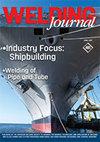填充金属16-8-2,适用于高温应用的304H和347H不锈钢结构焊接
IF 1.4
3区 材料科学
Q2 METALLURGY & METALLURGICAL ENGINEERING
引用次数: 2
摘要
检查了16-8-2型填充金属在304H和347H不锈钢结构焊缝中的应用情况,并分别与具有匹配填充金属308H和347的焊缝进行了比较。研究了高温暴露过程中的微观结构稳定性、焊缝金属的冲击性能和应力消除裂纹的敏感性。研究发现,16-8-2焊缝金属中的贫成分和低铁素体(约2铁素体数[FN])提供了高的金属间相形成阻力。尽管铁素体含量较低,但未观察到热裂纹。与匹配的填充金属焊缝相比,16-8-2焊缝金属显示出优异的韧性,尤其是在较长的高温暴露之后。提出了16-8-2时效焊缝金属在冷却至环境温度时发生某些马氏体转变的实验证据,并解释了在1300°F(705°C)焊后热处理后磁响应(如FN)的增加。在应用的测试条件下,没有一种测试的焊接金属因应力消除开裂机制而失效。与匹配的填充金属焊缝相比,16-8-2填充金属焊缝在高温暴露期间表现出显著较低的应力消除水平,并且在高温保持后表现出显著较高的拉伸强度。本文章由计算机程序翻译,如有差异,请以英文原文为准。
Filler Metal 16-8-2 for Structural Welds on 304H and 347H Stainless Steels for High-Temperature Service
The use of Type 16-8-2 filler metal was examined for application in structural welds on 304H and 347H stainless steels for high-temperature service applications and compared to welds with matching filler metals 308H and 347, respectively. Microstructural stability during elevated temperature exposure, weld metal impact properties, and susceptibility to stress-relief cracking were examined. It was found that the lean composition and low ferrite (~ 2 Ferrite Number [FN]) in 16-8-2 weld metal provide high resistance to intermetallic phase formation. No hot cracking was observed despite the low ferrite level. The 16-8-2 weld metals displayed superior toughness as compared to the matching filler metal welds, especially after longer elevated-temperature exposure. Experimental evidence for some martensite transformation in aged 16-8-2 weld metal upon cooling to ambient temperature was presented and explained an increase in magnetic response (as FN) after postweld heat treatment at 1300 ̊F (705 ̊C). None of the tested weld metals failed by stress-relief cracking mechanisms under the applied test conditions. The 16-8-2 filler metal welds exhibited significantly lower levels of stress relief during high-temperature exposure and significantly higher tensile strength after high-temperature hold as compared to the matching filler metal welds.
求助全文
通过发布文献求助,成功后即可免费获取论文全文。
去求助
来源期刊

Welding Journal
工程技术-冶金工程
CiteScore
3.00
自引率
0.00%
发文量
23
审稿时长
3 months
期刊介绍:
The Welding Journal has been published continually since 1922 — an unmatched link to all issues and advancements concerning metal fabrication and construction.
Each month the Welding Journal delivers news of the welding and metal fabricating industry. Stay informed on the latest products, trends, technology and events via in-depth articles, full-color photos and illustrations, and timely, cost-saving advice. Also featured are articles and supplements on related activities, such as testing and inspection, maintenance and repair, design, training, personal safety, and brazing and soldering.
 求助内容:
求助内容: 应助结果提醒方式:
应助结果提醒方式:


